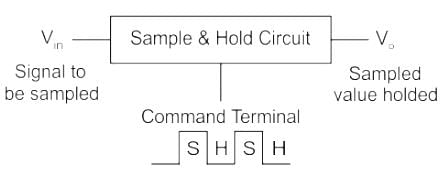GATE Exam > GATE Questions > Sample-and-hold circuits in ADCs are designed...
Start Learning for Free
Sample-and-hold circuits in ADCs are designed to:
- a)sample and hold the output of the binary counter during the conversion process
- b)stabilize the ADCs threshold voltage during the conversion process
- c)stabilize the input analog signal during the conversion process
- d)sample and hold the ADC staircase waveform during the conversion process
Correct answer is option 'C'. Can you explain this answer?
Verified Answer
Sample-and-hold circuits in ADCs are designed to:a)sample and hold the...
1. Sample & Hold Circuit is used to sample the given input signal and to hold the sampled value.
2. Sample and hold circuit is used to sample an analog signal for a short interval of time in the range of 1 to 10 µS and to hold on to its last sampled value, until the input signal is sampled again.
3.The holding period may be from a few milliseconds to several seconds.

Applications of Sample & Hold circuits:
- Out of different ADCs, successive approximation type ADC uses an S/H circuit, where the signal is to be held constant while A to D conversion is taking place.
- They are also used in DACs for the same purpose.
- It is used in analog demultiplexing in data distribution and in analog delay lines.
- In general, S/H circuits are used in all applications where it is necessary to stabilize the analog signal for further processing.
Most Upvoted Answer
Sample-and-hold circuits in ADCs are designed to:a)sample and hold the...
Explanation:
In an ADC (Analog-to-Digital Converter), the conversion process involves converting an analog input signal into a digital representation. One of the key components in an ADC is the sample-and-hold circuit.
Function of Sample-and-Hold Circuit:
The sample-and-hold circuit is designed to stabilize the input analog signal during the conversion process. It performs two main functions:
1. Sampling the Input Signal:
The first function of the sample-and-hold circuit is to sample the input analog signal. It captures and holds the voltage level of the input signal at a specific point in time. This is crucial because the conversion process in an ADC requires a fixed voltage level for accurate conversion. By sampling the input signal, the sample-and-hold circuit ensures that the ADC receives a consistent and stable voltage level to perform the conversion accurately.
2. Holding the Sampled Voltage:
The second function of the sample-and-hold circuit is to hold the sampled voltage for a specific duration. This is necessary because the conversion process takes some time to complete, and during this time, the voltage level of the input signal might change. By holding the sampled voltage, the sample-and-hold circuit ensures that the ADC receives a constant input voltage throughout the conversion process, which improves the accuracy of the conversion.
Importance of Stabilizing the Input Analog Signal:
Stabilizing the input analog signal is crucial because the accuracy of the ADC conversion depends on the consistency of the input voltage level. Any fluctuations or changes in the input voltage can introduce errors in the conversion process, leading to inaccurate digital representations of the analog signal.
Conclusion:
In summary, sample-and-hold circuits in ADCs are designed to stabilize the input analog signal during the conversion process. They sample the input signal to capture a fixed voltage level and hold it throughout the conversion process to ensure accurate and reliable conversions.
In an ADC (Analog-to-Digital Converter), the conversion process involves converting an analog input signal into a digital representation. One of the key components in an ADC is the sample-and-hold circuit.
Function of Sample-and-Hold Circuit:
The sample-and-hold circuit is designed to stabilize the input analog signal during the conversion process. It performs two main functions:
1. Sampling the Input Signal:
The first function of the sample-and-hold circuit is to sample the input analog signal. It captures and holds the voltage level of the input signal at a specific point in time. This is crucial because the conversion process in an ADC requires a fixed voltage level for accurate conversion. By sampling the input signal, the sample-and-hold circuit ensures that the ADC receives a consistent and stable voltage level to perform the conversion accurately.
2. Holding the Sampled Voltage:
The second function of the sample-and-hold circuit is to hold the sampled voltage for a specific duration. This is necessary because the conversion process takes some time to complete, and during this time, the voltage level of the input signal might change. By holding the sampled voltage, the sample-and-hold circuit ensures that the ADC receives a constant input voltage throughout the conversion process, which improves the accuracy of the conversion.
Importance of Stabilizing the Input Analog Signal:
Stabilizing the input analog signal is crucial because the accuracy of the ADC conversion depends on the consistency of the input voltage level. Any fluctuations or changes in the input voltage can introduce errors in the conversion process, leading to inaccurate digital representations of the analog signal.
Conclusion:
In summary, sample-and-hold circuits in ADCs are designed to stabilize the input analog signal during the conversion process. They sample the input signal to capture a fixed voltage level and hold it throughout the conversion process to ensure accurate and reliable conversions.
Free Test
FREE
| Start Free Test |
Community Answer
Sample-and-hold circuits in ADCs are designed to:a)sample and hold the...
1. Sample & Hold Circuit is used to sample the given input signal and to hold the sampled value.
2. Sample and hold circuit is used to sample an analog signal for a short interval of time in the range of 1 to 10 µS and to hold on to its last sampled value, until the input signal is sampled again.
3.The holding period may be from a few milliseconds to several seconds.

Applications of Sample & Hold circuits:
- Out of different ADCs, successive approximation type ADC uses an S/H circuit, where the signal is to be held constant while A to D conversion is taking place.
- They are also used in DACs for the same purpose.
- It is used in analog demultiplexing in data distribution and in analog delay lines.
- In general, S/H circuits are used in all applications where it is necessary to stabilize the analog signal for further processing.

|
Explore Courses for GATE exam
|

|
Question Description
Sample-and-hold circuits in ADCs are designed to:a)sample and hold the output of the binary counter during the conversion processb)stabilize the ADCs threshold voltage during the conversion processc)stabilize the input analog signal during the conversion processd)sample and hold the ADC staircase waveform during the conversion processCorrect answer is option 'C'. Can you explain this answer? for GATE 2025 is part of GATE preparation. The Question and answers have been prepared according to the GATE exam syllabus. Information about Sample-and-hold circuits in ADCs are designed to:a)sample and hold the output of the binary counter during the conversion processb)stabilize the ADCs threshold voltage during the conversion processc)stabilize the input analog signal during the conversion processd)sample and hold the ADC staircase waveform during the conversion processCorrect answer is option 'C'. Can you explain this answer? covers all topics & solutions for GATE 2025 Exam. Find important definitions, questions, meanings, examples, exercises and tests below for Sample-and-hold circuits in ADCs are designed to:a)sample and hold the output of the binary counter during the conversion processb)stabilize the ADCs threshold voltage during the conversion processc)stabilize the input analog signal during the conversion processd)sample and hold the ADC staircase waveform during the conversion processCorrect answer is option 'C'. Can you explain this answer?.
Sample-and-hold circuits in ADCs are designed to:a)sample and hold the output of the binary counter during the conversion processb)stabilize the ADCs threshold voltage during the conversion processc)stabilize the input analog signal during the conversion processd)sample and hold the ADC staircase waveform during the conversion processCorrect answer is option 'C'. Can you explain this answer? for GATE 2025 is part of GATE preparation. The Question and answers have been prepared according to the GATE exam syllabus. Information about Sample-and-hold circuits in ADCs are designed to:a)sample and hold the output of the binary counter during the conversion processb)stabilize the ADCs threshold voltage during the conversion processc)stabilize the input analog signal during the conversion processd)sample and hold the ADC staircase waveform during the conversion processCorrect answer is option 'C'. Can you explain this answer? covers all topics & solutions for GATE 2025 Exam. Find important definitions, questions, meanings, examples, exercises and tests below for Sample-and-hold circuits in ADCs are designed to:a)sample and hold the output of the binary counter during the conversion processb)stabilize the ADCs threshold voltage during the conversion processc)stabilize the input analog signal during the conversion processd)sample and hold the ADC staircase waveform during the conversion processCorrect answer is option 'C'. Can you explain this answer?.
Solutions for Sample-and-hold circuits in ADCs are designed to:a)sample and hold the output of the binary counter during the conversion processb)stabilize the ADCs threshold voltage during the conversion processc)stabilize the input analog signal during the conversion processd)sample and hold the ADC staircase waveform during the conversion processCorrect answer is option 'C'. Can you explain this answer? in English & in Hindi are available as part of our courses for GATE.
Download more important topics, notes, lectures and mock test series for GATE Exam by signing up for free.
Here you can find the meaning of Sample-and-hold circuits in ADCs are designed to:a)sample and hold the output of the binary counter during the conversion processb)stabilize the ADCs threshold voltage during the conversion processc)stabilize the input analog signal during the conversion processd)sample and hold the ADC staircase waveform during the conversion processCorrect answer is option 'C'. Can you explain this answer? defined & explained in the simplest way possible. Besides giving the explanation of
Sample-and-hold circuits in ADCs are designed to:a)sample and hold the output of the binary counter during the conversion processb)stabilize the ADCs threshold voltage during the conversion processc)stabilize the input analog signal during the conversion processd)sample and hold the ADC staircase waveform during the conversion processCorrect answer is option 'C'. Can you explain this answer?, a detailed solution for Sample-and-hold circuits in ADCs are designed to:a)sample and hold the output of the binary counter during the conversion processb)stabilize the ADCs threshold voltage during the conversion processc)stabilize the input analog signal during the conversion processd)sample and hold the ADC staircase waveform during the conversion processCorrect answer is option 'C'. Can you explain this answer? has been provided alongside types of Sample-and-hold circuits in ADCs are designed to:a)sample and hold the output of the binary counter during the conversion processb)stabilize the ADCs threshold voltage during the conversion processc)stabilize the input analog signal during the conversion processd)sample and hold the ADC staircase waveform during the conversion processCorrect answer is option 'C'. Can you explain this answer? theory, EduRev gives you an
ample number of questions to practice Sample-and-hold circuits in ADCs are designed to:a)sample and hold the output of the binary counter during the conversion processb)stabilize the ADCs threshold voltage during the conversion processc)stabilize the input analog signal during the conversion processd)sample and hold the ADC staircase waveform during the conversion processCorrect answer is option 'C'. Can you explain this answer? tests, examples and also practice GATE tests.

|
Explore Courses for GATE exam
|

|
Signup for Free!
Signup to see your scores go up within 7 days! Learn & Practice with 1000+ FREE Notes, Videos & Tests.


















